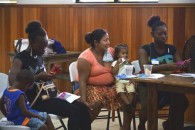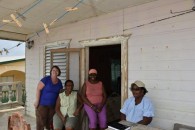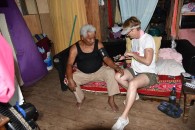On Sat., June 13, Shary Yerk and I participated in a LIMM CHE (Community Health Education) project in Seine Bight, Belize. Seine Bight is a village on the south eastern coast of Belize, near Placencia. The village is home to approx. 1200 people of Garifuna and Hispanic descent. During 4 days of mission work, Shary and I were able to lead 5 educational sessions on Diabetes Education. Our original plan was to work with the school aged children in the village, but due to school final exams, and family obligations, were had to shift our plans to work with the young (15 to 30 year old) adult women. Two classes were taught to the Spanish villagers, and two classes to the Garifuna women. A total of 18 women and youth participated in the sessions. Sheila Morrall assisted us with interpretation for the Spanish teaching.
In addition, we met and instructed a group of 3 ladies, one a former RN, one a CNA and one a community volunteer, Miss Joan, Miss Elaine, and Miss Winnie.
These ladies have started a community feeding program for the elderly, and having been out of practice for several years, were very eager to be part of the diabetic teaching. They were given the course, and return demonstrated the teaching concepts of Diabetes. Besides the feeding program, they have become the community “home health” nurses, working strictly as volunteers to help those in need of teaching and care. There are several patients in the community that have diabetes, and the families are responsible for the care. The family members receive no education during hospitalization of their loved ones, and are often criticized and scolded for asking questions of the nursing staff. Patient education is virtually non-existent in the country. Joan, Winnie and Elaine are very interested in helping their community, and in setting up a regular visit schedule to continue teaching the patients and their caregivers. They have asked for assistance in obtaining one or two glucometers that they can use during their visits to patients homes.
The homes in the Spanishville region are built round the swamp and dump.
Pictured above is an extremely polluted lagoon that surrounds the homes. We crossed a very rickety foot bridge to enter the region, and make home visits to two newly diagnosed diabetic patients. One on one teaching was given to the 16 year old granddaughters that are responsible for caring for their grandparents. In one case, the granddaughter told me she was threatened to be kicked out of the hospital for asking the nurse about her grandfathers’ medications, and instructions on diet. His discharge instructions were to eat only fruits and vegetables, and to come back for a blood sugar check in 3 months.
Here is a picture of Shary working with Juan, a new diabetic, who was hospitalized for 12 days.
Below, Sharon is teaching Felicia, an English speaking resident from Spanishville.
The women were very interested in the education and participation in the return demonstration class was excellent.
We were also able to work with two nursing students, Andrea Whitehouse, and Sarah Long. Both were present and participated in the teaching as well as the home visits.
In addition to the diabetes teaching, Shary and I met with several residents and discussed end of life care and their culture. The overall consensus is that the residents do not want a home hospice program yet. They prefer to go to the hospital for end of life care. This has much to do with the Garifuna religion, and their beliefs that ancestors continue to guide them, and dying in the home brings darkness to the home. Culturally, we feel we must respect their customs, and work slowly with the church to bring Christianity to the people. Further community health assessment revealed a very strong desire for teaching of hypertension and heart health classes. This would be a very beneficial course for future trips.
Shary and I, along with Andrea and Sarah, performed several home visits as well. Besides the diabetic patients, the care we gave included a 10 year old with a sting ray barb in his ankle (who we took to the medical center 10 miles away for immediate care), a construction worker who had a puncture wound in his foot from a drill that fell off a roof, 2 recent amputees (from complications of diabetes), 2 stroke patients who were recovering very slowly with care from their family, and 2 children with Cerebral Palsy who receive ongoing assistance from the Belize Mission Society.
We were very humbled to have been able to serve the villagers of Seine Bight, and are very appreciative of the assistance we received from LIMM. The village is in much need of ongoing prayer, and medical teaching in the form of CHE programs, and will continue to excel with the excellent community leaders that have stepped forward to learn and continue teaching the programs.
Sharon Thomas






